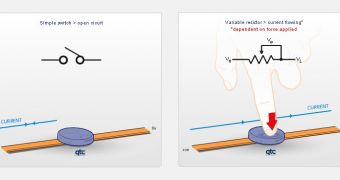Touch technology has been evolving at a rather rapid pace, with multitouch capabilities improving so much that it is now at a level where it can intuitively detect multiple inputs. What the technology has so far been unable to accomplish, however, is detect the amount of pressure applied on the screen. This issue seems to have finally been solved, as UK researchers from Peratech came up with a “novel quantum mechanism to sense pressure.”
The process by which pressure can be recognized is dubbed quantum tunneling and is made possible thanks to an electrically conductive material, predictably dubbed quantum tunneling composite (QTC). The process occurs when electrons jump between two conductors that are brought close together, but both conductors must be separated by an insulating layer.
The layers from Peratech's switches are made of polymers embedded with 10nm-sized spiky, conductive metallic particles. This 75-micrometer composite can be easily added to existing screens and Japanese display manufacturer Nissha has already licensed the technology.
“These are polymer materials that change their resistance as force is applied,” Philip Taysom, Peratech's CEO, says. So, as force is applied, these particles are brought closer together. “As they come into proximity, they allow quantum tunneling.”
The especially convenient feature of this technology is that it is easy and cheap to implement, while promising to provide very accurate and highly sensitive pressure detection. In fact, the layer only needs two micrometers of movement to register a touch and the sensors draw no power in absence of touch input.
“The harder you press, the faster the screen will scroll or the faster a character will run in a game,” Taysom adds. This functionality, according to Taysom, should also improve operations such as drag and drop and simultaneous dragging and zooming images, among other things.
Nissha manufactures displays for companies such as LG and Nintendo. The first quantum tunneling-based products should debut during April 2010.

 14 DAY TRIAL //
14 DAY TRIAL //